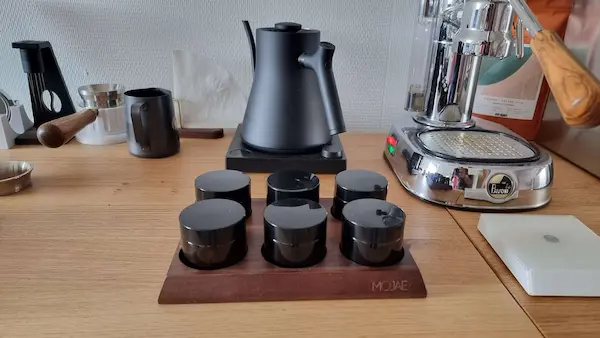For those with a passion for coffee, the quest for the perfect cup is a never-ending journey. A rising trend that’s capturing the attention of coffee enthusiasts everywhere is the practice of “single dosing”. In this article, we’ll delve into the ins and outs of this intriguing method, discussing its pros and cons, and offering guidance on how you can seamlessly incorporate it into your daily coffee ritual. So, brace yourself for an exciting deep dive into the captivating realm of single dosing!
Unraveling the Concept of Single Dosing
Single dosing is a unique approach to coffee preparation where coffee beans are weighed and ground right before they’re used. This method stands apart from the conventional practice of scooping a certain amount of coffee with a teaspoon or another measuring instrument. Single dosing champions the concepts of freshness and accuracy by weighing each dose separately. Consequently, you’ll always find our grinder’s reservoir empty, ready for the next fresh batch.
Exploring the Benefits of Single Dosing
Preserves freshness and aroma
Embracing the practice of single dosing presents a significant perk – the freshness of your coffee. When you grind your beans immediately before brewing, you’re safeguarding the coffee’s delicate aromas and intricate flavours. This method ensures that every cup of coffee you enjoy is not just fresher, but also more flavourful.
Precision and reproducibility
Single dosing allows for an exact measurement of coffee used for each brew. This level of accuracy ensures consistent results, a crucial factor for coffee enthusiasts aiming to master their brewing techniques.
Flexibility and experimentation
With the single dosing method at your disposal, tailoring the quantity of coffee for each brew becomes a breeze. This method opens up a world of possibilities, allowing you to play around with various coffee-to-water ratios until you discover the ideal blend that suits your taste buds perfectly.
Exploring the Drawbacks of Single Dosing
Extra time and effort
Embracing the single dosing approach might demand a tad more time and effort compared to the conventional way of preparing coffee. This method involves weighing your beans for each brew and fine-tuning your coffee grinder to achieve the perfect grind. Yet, for many coffee enthusiasts, this additional step is a small price to pay for the promise of an exceptional cup of coffee.
Investment in additional equipment
Embracing the single dosing method requires a few key tools: a high-quality coffee grinder, an appropriate reservoir, compact containers, and most importantly, a precision scale to measure your coffee doses accurately. While this might mean a slightly higher upfront cost, for those who truly love their coffee, it’s an investment that promises to enhance your brewing experience.
Highlight: The Encore ESP, the newest model from Baratza, features an optional tank designed specifically for single dosing.

Grind retention
It seems logical to assume that if you start with 20.0 g of coffee beans, you’ll end up with the same weight, 20.0 g, in ground coffee, doesn’t it?
However, it’s not always smooth sailing. Issues can arise when coffee beans become lodged in the grindstones or at the mill outlet. This can pose a challenge if you’re interested in single dosing, as it’s crucial to ensure your grinder can handle grinding just a portion of beans. Some grinders, particularly commercial models (which can often be found at bargain prices on Le Bon Coin), need a full hopper to function optimally. These grinders depend on the weight of the beans in the hopper to exert pressure on the grinding wheels, resulting in a consistent grind. When used for single dosing, these grinders may retain more than 2g of coffee. So, if you grind 20g, you might only get 18g, which is a significant discrepancy.
It’s important to note that regardless of the quality of your grinder, a minimal amount of retention is inevitable. However, some models, such as the renowned Niche Zero or the Kopi Deva, boast near-zero retention.
Popcorn effect
As we touched on before, certain grinders require the pressure from a full container of beans to ensure they’re evenly processed through the grinding wheels. If you’re attempting to grind a smaller amount of coffee, you might encounter a phenomenon known as “popcorning”. This can result in an inconsistent grind.
Our friends at Coffee Ad Astra have conducted an insightful study on this topic. Feel free to dive into their findings right here:
Consider opting for mills that are specifically designed for single dosing, as they typically don’t face significant issues in this area. However, be aware that larger mills, which are traditionally used in the foodservice industry – like those from Santos, Mazzers, and Eureka – may potentially encounter this problem.
Having gained a solid understanding of single dosing, along with its pros and cons, let’s explore some handy tips to seamlessly integrate this method into your coffee brewing ritual:
- Invest in a quality coffee grinder for even, precise grinding.
- Use a precision scale to measure each dose of coffee accurately.
- Experiment with different coffee/water ratios to find the taste that suits you best.
- Be patient and ready to adjust your preparation parameters to achieve perfection.
Would you like another cup of coffee?
Let’s dive into the conversation! Join us over at the Coffeegeek Discord server and let’s chat.

Leave a Reply